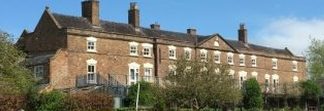Last time, Mrs Bliss noted that in the past, there was no sophisticated treatment or much state help for anyone ill, old or disabled, but that there was genuine care and neighbourliness ‘in the community’.
There was, however,:-
The Workhouse
On the subject of care, the Eastington Parish Workhouse was built in 1785 of Frampton Brick, “for the help of the poor”, being half hospital and half factory, as there was work to be done for the upkeep in its walls and garden. (In 1836, with the new Poor Laws, it was adopted by the Wheatenhurst Poor Law Union to serve a wider area). On the banks for the Stroudwater Canal, facing southwest, it was a pleasant looking two-storey building with an imposing façade which actually did resemble the hospitals of the day.
 A wide railed balcony ran the whole front of the building which was used to advantage in fine weather, as there were glass panelled doors opening on to it where the patients beds could be wheeled out for them to enjoy the sunshine.
A wide railed balcony ran the whole front of the building which was used to advantage in fine weather, as there were glass panelled doors opening on to it where the patients beds could be wheeled out for them to enjoy the sunshine.
There was a lodge for the Porter near the back entrance in which (I think) the married couple who were cook and porter lived. As I lived next door, it was a large part of my childhood, as with the other children from nearby we played in the grounds with the family of the “Master and Matron” as they were then known.
There were places for both men and women, who had been taken there for a variety of reasons. Some may have become homeless, but a few of the women were there for having had an illegitimate child and had nowhere else to go. Those that were living there during my childhood I remember very well. They were not up to the standard expected for education so this was their only refuge. There was work for them in the kitchens and laundry; whether they were ever paid for their work I have no idea. One that I recall was Ada, who was profoundly deaf and because of it was unable to speak with any clarity. She was there because she had a child and for some reason was able to keep her child with her until she was about 7 years old. She came to the local primary school with me and I remember her as a pretty little girl with curls. I have often wondered since what happened to her.
Another unfortunate was Amy who had a sub-normal son (as they were called in those days) who was taken from her and I believe put in a home in Bristol. She was a dear soul, but not too bright and she too worked in the kitchens. She was there when I was born next door and lived until I had a grandchild, certainly a lifetime.
Living where we did, just a stones throw from the workhouse, we knew them all well. My mother visited most Sundays with flowers and little treats. The old ladies would sit in the Day Room on forms (no easy chairs) and they all wore calico dresses, some pink, some blue, with nothing at all to do, and they welcomed visitors. I often went with my mother, and I remember, young as I was, how sorry I felt for them. The men also had a room where they could smoke, which must have been some consolation. They wore suits of hardwearing material.
In spite of the conditions they were cared for with kindness and the standard was high with regard to the knowledge at the time. As I have said a lot of the work in the kitchens was done by the women there, and poor Ada always seemed to have her arms swathed in bandages from scalds and burns.
On the outside of the main building next to the road was another long low building which had large iron gratings let into the wall. Outside these were mounds of granite stones. Any tramp that wanted a bed for the night have to break the stones into small enough chippings to through the holes in the grating and when the pile the other side was considered the right amount, he had earned a nights lodging. These chippings were then used for roads.
In the grounds was a small building almost like a little bungalow where a lady who came every day from Stroud did all the sewing and mending for the home.
I cannot remember bed cases in the early days as we never ventured upstairs but undoubtedly there were. When the NHS was formed, it was turned into a geriatric hospital for local people, especially those who were terminally ill. The active residents, who had been there so long, stayed there and were nursed when the time came. They had a fully qualified nursing staff and the care was second to none as personally I witnessed. Those men who were able, did a little gardening and worked in the large conservatory.
Each week a short service was held, which many of them enjoyed – especially the hymn singing – taken by a member of the local Methodist Church.
Things did improve and attitudes changed. The name was altered to the Willows as Workhouse had such a stigma.
After laying empty for some years, it was eventually bought (rescued) by the Rudolf Steiner organization and completely renovated as William Morris House.
It has continued to be modernised and expanded with the addition of many new facilities and is now part of the William Morris College – which offers a wide range of services for children and young adults with learning difficulties and special needs.



You must be logged in to post a comment.